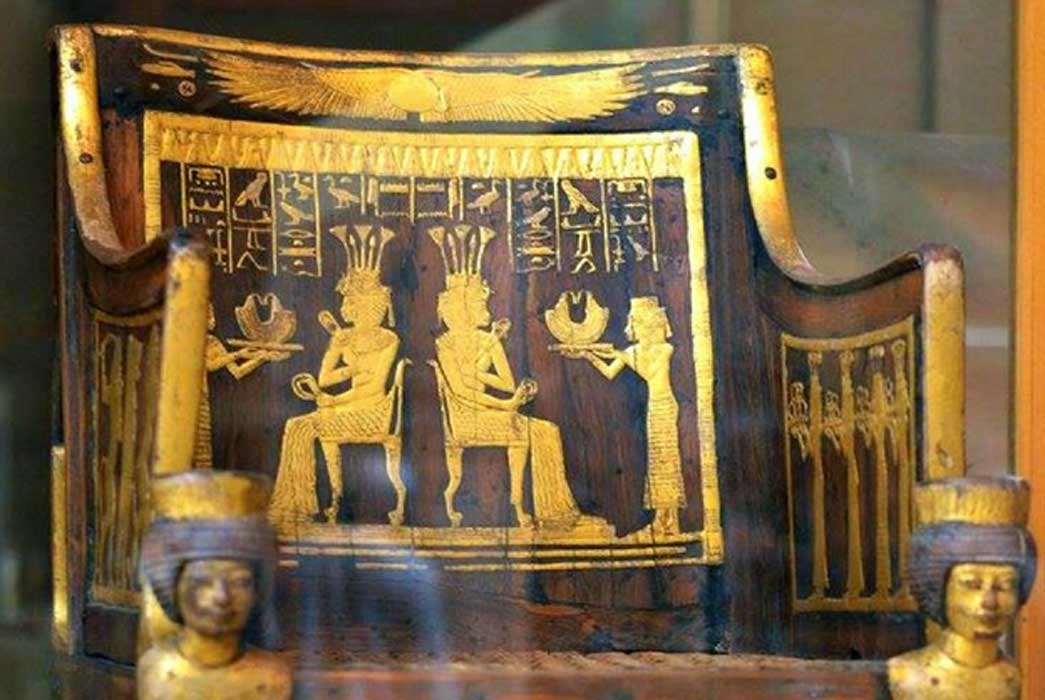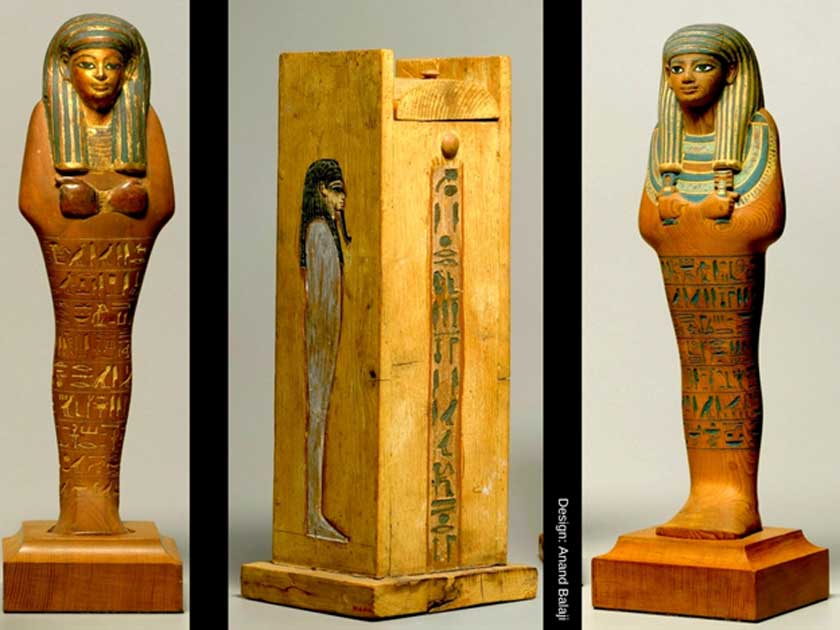
Bedazzling Treasures of Yuya and Tjuyu: Stunning Burial on a Par with Royalty – Part II
With their daughter, Tiye, married into the powerful ruling family of Egypt, Yuya and Tjuyu led a charmed life. With strong ties to their hometown Akhmin, Yuya seems to have participated actively in affairs of state – guiding the young Amenhotep III as he learned the ropes – with the consent of his purported sister, Mutemwiya. In admiration of the immense contributions of Yuya and Tjuyu, their grateful son-in-law prepared a sumptuously-stocked tomb in the sacred Valley of the Kings. However, grave robbers plundered KV46 on more than one occasion.

These superb, partially gilded and painted cedar shabtis of Yuya, father-in-law of Amenhotep III, were discovered during excavations by Quibell and Weigall in 1905. (Center) Shabti box of Yuya. Metropolitan Museum of Art, New York.
The Rich Contents of KV46
The tomb of Yuya and Tjuyu proved to be one of the few non-royal burials in the Kings’ Valley. A joint sepulcher, the funerary goods found here ranked among the most exquisite New Kingdom furniture; before Howard Carter’s spectacular discovery 17 years later – the tomb of Tutankhamun. Upon unwrapping the mummies, anatomist Grafton Elliot Smith declared that the remarkably well-preserved mummy of Yuya was one of the finest examples of the extraordinary embalming technique employed during the celebrated 18th Dynasty.

(Clockwise) The excellent state of preservation of the mummies of Yuya and Tjuyu bear testimony to the skill of 18th-Dynasty embalmers; an excavation assistant stands beside the 2.75 meter outermost coffin of Yuya shortly after its discovery (Public Domain); this, the most perfectly preserved and beautiful of the series of seven anthropoid coffins of Tuya, is, except for the eyes and the necklace, entirely covered in gold. Egyptian Museum, Cairo. (Photo: Heidi Kontkanen)
The massive 2.75 meters (9 feet) outermost coffin of Yuya was styled after the popular 18th- Dynasty ‘black’ coffers, which Dr Ikram and Dr Aidan Dodson state made its advent under Pharaoh Hatshepsut; gaining widespread acceptability all the way up to the reign of Ramesses the Great. Yuya’s anthropoid coffin is Osiride in appearance. The major parts of the body such as the hands, face, inscriptions, wig, and figures of protective deities are magnificently gilded; while the rest of the body is painted with black pitch, owing to the association of this color with fertility and rebirth. Along the sides, the Four Sons of Horus adorn the coffin and canopic assemblage. The enormous lid of this outermost coffin was discovered lying on the floor of the crypt, resting against the sarcophagus. This was the handiwork of plunderers who ransacked the tomb for valuables.
Like that of his wife, Yuya's mummy was equipped with openwork cartonnage which was likened to a ‘cage’ coated with a thin layer of plaster, inscribed and covered with gold foil. Interesting, Tjuyu’s eyelids were filled with cotton-like material and painted to imitate human eyes! Based on noticeable differences in the manner of embalming the two mummies, Gaston Maspero opined that Yuya passed away before his wife - a proposal that is widely accepted by Egyptologists down to this day. Also, based on purely stylistic comparisons in the burial assemblages, in particular the canopic jars, Dr Nicholas Reeves assessed that Yuya and Tjuyu died at different times.
KV46 yielded a brilliant surprise in the form of the first ever intact ancient Egyptian chariot to ever be found – before the collection in KV62 came to light. Other items included a jewelry box decorated with mosaic of ivory, ebony and faience, with inscriptions in gold and a model coffin of inlaid wood decorated with blue faience tiles carrying the names of Amenhotep III and Tiye. Two chairs belonging to Sitamun, considered to be the eldest daughter of Amenhotep III, whom the king elevated to the role of Great Royal Wife during his first Sed festival in his 30th Regnal Year, were also found in the tomb of her grand-parents. It must be noted that the largest of these chairs was used by French Empress Eugénie during her visit to Egypt to inaugurate the Suez Canal.




